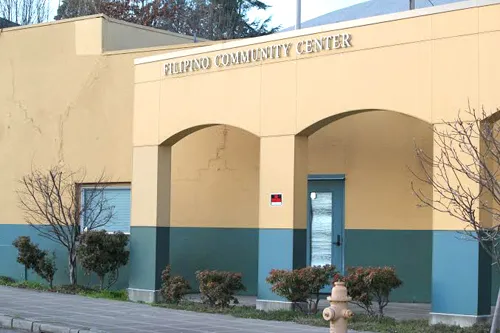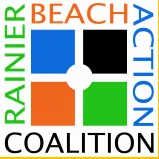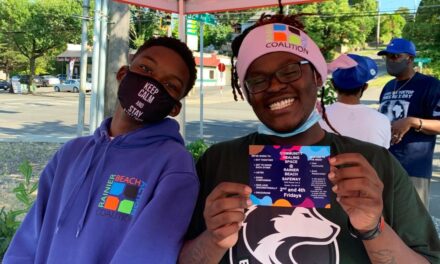Holding Space: Philip B

Growing up
When I was about 11 or 12, my aunt was living with her daughter near 38th and Holly right off of MLK. I’ll never forget it. My cousin — who’s two years older, helped me conquer my fears. I was always this nerdy young child who liked to have his nose in the books, whereas he was the cool Filipino kid who loved to wear Nike’s. We were polar opposites. For some reason, he perhaps felt empathetic for me — or sympathetic.
I will never forget my cousin telling me, ‘Philip you don’t need to be scared of everyone or everything’. He used to take me on the back of his bike, and we’d ride throughout 37th Avenue South, go up that hill towards Beacon Hill, and then we would ride down Beacon [Ave S] and go all the way down to [S] Alaska [St] to explore the area. That’s why I like to consider myself a son of Seattle.
I’ll always think living in Rainier Valley in the #Soufend has exposed me to different cultures.
I truly remember what Beacon Hill was what Chinatown was, what Rainier Valley was…I think these are some of my favorites, because he just framed it in a way that I needed. I didn’t need to be scared of everything, because I was even scared to learn how to ride a bike. He would take me on adventures around the area. (This was before the era of iPads, you have all these electronic distractions.)
I’ll always think living in Rainier Valley in the #Soufend has exposed me to different cultures. One of the biggest things that I want to live my life doing is traveling, listening to people’s stories, and doing things outside of my own ethnic and cultural identity. [Living in the South End has] given me more of a worldview, whereas if I had stayed in Chinatown, or if I had moved south to Auburn or Federal Way, would I still have the same worldview that I have today?
It’s just fascinating because I’ve grown up in Rainier Valley seeing firsthand all the changes. I remember when the light rail was being built. I remember when the new apartments on MLK and Othello were built. I remember when nothing was there. I remember when there was nothing on Alaska street. Now seeing the dramatic physical change of it is crazy every time I drive down Rainier or MLK Jr. S…
Gentrification:
When I was in high school, I was in a leadership program that took students from all the high schools in Seattle: north, south, west, and east. At this point in my life, I was living with my aunt full time in Rainier Valley.
This was the first time that I was exposed to people from the wealthier schools in the Seattle school district. Tho [white] individuals from the north and west of Seattle had to drive me home. I’ll never forget. (This brings up a lot of memories for me…) I’ll never forget when they were driving me back; we were going down MLK Way. They were laughing and saying, ‘Oh, do we need to lock our doors?’ and stuff like that.
Now you see these same white people trying to move into our neighborhood because it’s cheaper for them or hip for them. In the past, a white person wouldn’t want to step foot [here] because of the harmful stereotypes or what they thought the #Soufend was. Now, you’ll catch them being a part of all these advisory boards when it comes to talking about diversity when it comes to being accepting.
White people have [historically] let the Southend — I don’t want to say “disintegrate” — fall to pieces because it wasn’t on their agenda, because Ballard, Magnolia, Fremont, Wallingford, etc was where they all were. But now, these same people who would stay away from are now the same people in Columbia City that have signs that say: “All are welcome here”.
Now, white millennials that are a little older, are moving in, buying homes, or these apartment complexes are being built for them. Now, they want to clean up the Safeway on Othello. Now, they want to clean up certain areas of Martin Luther King [Jr. Way S.]. Now they want to make it look presentable.
But where was all of that before they all moved in?
I connect some of what has happened in the past, in terms of redlining, [with what] I see changing now. When I was growing up in the Rainier Valley, I would make jokes with my friends about not having anything nice here. Rainier Valley has always held these unfortunate stereotypes, when it came to Seattle politics, or Seattle culture. It was a place known [as being] a little poor. It was a place where everyone had to ride the bus to get to you. It was a place where there was a food desert. All we had was McDonald’s, Burger King, or other fast-food restaurants. We didn’t have the same access that areas that I thought I’d always want to be in Seattle have. I would always tell myself: ‘I’m going to be successful in my job, so I can live in Ballard, or so I can live in Magnolia.’
Now, white millennials that are a little older, are moving in, buying homes, or these apartment complexes are being built for them. Now, they want to clean up the Safeway on Othello. Now, they want to clean up certain areas of Martin Luther King [Jr. Way S.]. Now they want to make it look presentable.
But where was all of that before they all moved in?
Why couldn’t we have access to cleanliness, to sidewalks, to other resources before white millennials moved in?
Family & Community Connectedness
On a very personal level, my aunt goes to a Filipino Senior Center on its return near Van Asselt. During the pandemic, when the senior center was closed, my aunt expressed how lonely it can be, because that was where she was able to exercise, socialize, and do things that kept her on her feet. Without that, she’s been stuck at home.
We are living in the age of the Coronavirus, where everything can be a threat. Especially towards older people, especially towards older people of color — or older immigrants who may or may not have been receptive to staying at home at first. Being that her community center and her community place may not survive the end of the pandemic: it’s saddening.
I think people would be able to thrive more knowing that at least one thing in their life, their house, the roof over their head, could be stable. That would be extremely meaningful.
The International Drop-in Center (IDIC) serves a lot of lower middle-income Filipinos who don’t necessarily have a large home, or who may be on assisted living, or who may live in a multi-generational household, or who may not have the capacity to be able to host all these different people. [They may not have] the finances, or the time to do so. That’s why the importance of these community anchors is understated.
I’m speaking on behalf of the Filipino community, but I’m sure that it ranges and is the same throughout a lot of the different demographics in the #Soufend. It just makes me sad, because the financial ramifications of gentrification and COVID combined are just horrendous. I really hope community centers and gathering spaces are able to fully reopen after the pandemic, but it’s sad to think about what it would be if they don’t, and that mirrors a lot of the different organizations and community gathering places in south Seattle.*
I feel like the constant threat of displacement doesn’t allow people in these communities to live as authentically as they can or should. It would mean a lot because I have many family members who rent in the areas in Beacon Hill and Rainier Valley. It’s a constant conversation of when the lease renews. How much is this going to be, or, more specifically, I have a family member that is renting a small house in Beacon Hill, but the landlord is going to be selling the land to property development. So it’s this constant threat of: ‘What do I do next? What can I do next? How am I going to make my commute to my job in Seattle, if I have to live all the way in Federal Way, and I don’t drive? I have to live all the way in Auburn just to be able to survive, because rates are so expensive in Seattle.’
I don’t think that people came here from different countries to constantly feel like they need to be displaced. Being displaced is traumatic for a lot of immigrants. I can’t speak on that because I was born here, yet I know that in my family, the constant threat of housing instability, the constant threat of affordability, the constant threat of not having enough money by the end of the month, that’s a constant thing.
I think people would be able to thrive more knowing that at least one thing in their life, their house, the roof over their head, could be stable. That would be extremely meaningful.






